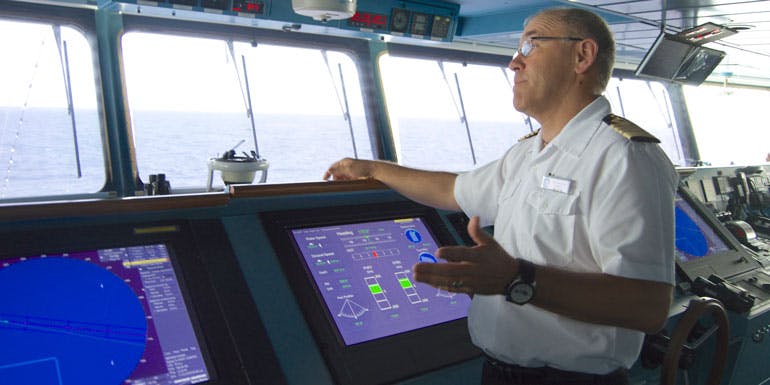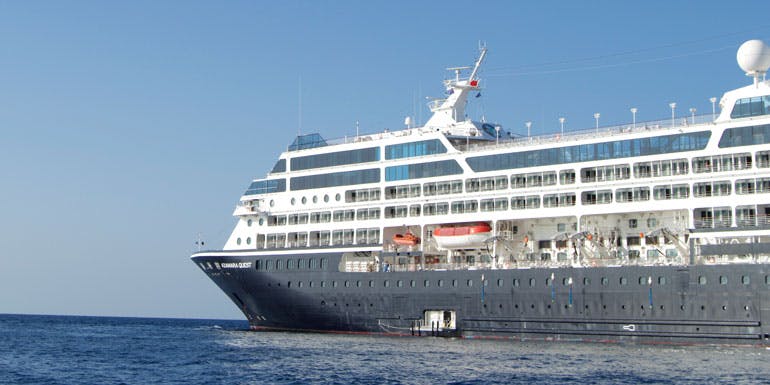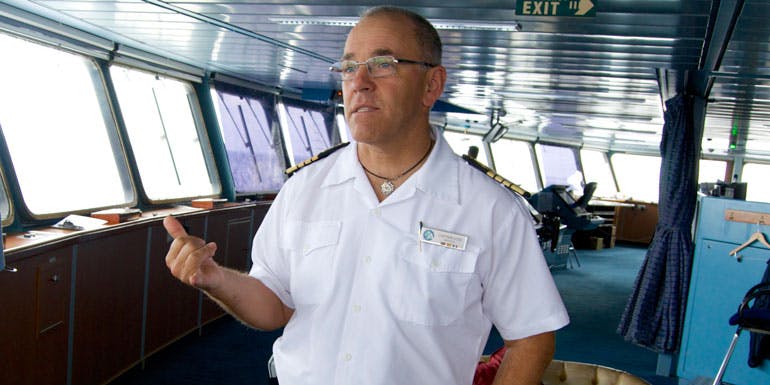What It's Like to Be a Cruise Ship Captain

Even if you’ve met a ship captain or two in the past, you probably didn’t have a chance to ask them every question you had about being in charge of an entire cruise ship--they’re pretty busy people, after all. This is why we jumped at the chance to interview Captain José Vilarinho of the Azamara Quest, and we made sure to ask him all the questions about being a cruise ship captain that you submitted to us on Facebook and Twitter.
Cruiseline.com: This isn't exactly a common career choice... what inspired you to become a cruise ship captain?
Captain José: My dream was to be a skipper on a fishing trawler, on my family’s cod fishing boat. It was my family’s business. I have uncles and several cousins working there, and it was my dream to follow them. After the first trip, I realized it was a big disappointment for me and I went to the cargo ships. From there, as my career progressed and I rotated onto a cruise ship that was doing a world cruise back in 1989. As soon as I did my work on a cruise ship, I said this is what I want to do if I continue working on ships. I was very lucky to have followed a path from trawlers to tankers to container ships and ended up with a better life on a cruise ship. Some seamen don’t like cruise ships because of all the rules and regulations and social life requirements. But I’m very lucky. This is what I want to do and I’m very happy.
I was very lucky to have followed a path from trawlers to tankers to container ships and ended up with a better life on a cruise ship.
CL: New cruisers often ask us whether or not cruising is a safe way to travel. Is it a safe vacation, and what can you tell them to assuage their fears?
CJ: There are two benchmarks in this industry that are very important to us: Titanic and Costa Concordia. These two incidents really changed a lot of things.
Titanic led to the Safety of Life at Sea act and regulations requiring a certain number of lifeboats and other safety equipment. After Costa Concordia, came the “dual watch” operation. Before that, all the ships operated with one officer on the Bridge. That means one person in charge, one officer on the Bridge. Studies and evaluations show that as the ships get bigger, the Bridges are getting bigger and bigger and too much equipment too much for one person to do, including a lot of paperwork running parallel to the navigation, what we call the checklists, to make sure we don’t miss anything. There’s so much technology on such big ships that we can no longer rely just on our memory.

Captain José explains the intricacies of running a cruise ship. - Photo by Simon Duvall
It is safe to cruise, and now people can feel even more relaxed and more safe, because we have an extra set of eyes on the Bridge. There are a lot of safety drills that we have to carry out now. Before Concordia, the passenger safety drill was supposed to be done within the first 24 hours of boarding the ship. Now, it is very clear that every passenger must go through the drill before the ship leaves the port. We never know when an emergency will happen. It can happen the first night, and unfortunately it happened the first night of the cruise for the Concordia guests who embarked in Civitavecchia. All these small things are lessons learned from having accidents and improving safety. The new drills, the new technology, the new equipment have increased safety onboard.
CL: Even smaller cruise ships are pretty large vessels. How difficult is it to dock the ship in port?
CJ: Every time we have to pull into a port, first of all we have to do a risk analysis of what can go wrong and look at every maneuver. It’s part of the briefing I have to do with my officers. A question that is always present on preparation for the arrival is: how am I going to get out?
We can handle the waves and the swells and the rain but the worst thing for me is the wind. In port, it’s a very strong enemy in port because the ship is stopped so any wind can impact you. Normally, we take the ship in whatever will be the easiest way to get the ship out. Unless there is no other alternative.
In Civitavecchia, the authorities say that it is compulsory to be parked port side of the ship alongside the dock. Why? Because they want all the ships bow out so that if there’s an emergency or something goes wrong, they want the ships to be able to just cast off and go. There would be no time for swinging and maneuvers.
And some other times, if weather conditions allow, I think to put the ship with the bow out so guests can get the better picture of the front of the ship. It’s nice when a guest is returning to the ship from the town and you have the bow of the ship right there to take that perfect shot. This is a detail I like to have in consideration. It’s the details.

Azamara Quest off the coast of Chania, Greece - Photo by Simon Duvall
CL: What’s your biggest challenge in a typical day or a typical cruise?
CJ: Every day is different here on the ship. So many people think it’s a boring life, every day is the same thing. But no, it’s not the same. Every day can be a stark difference.
I would be very concerned right now if an engineer called me and said we can’t make the speed to get in port on time tomorrow. That would be a big challenge. I’d have to look at what we can do to fix the problem. Can we put another engine on? Can we somehow fix what’s wrong? Because the snowball of this small phone call can be huge at the end of the day or into tomorrow.
Otherwise, our challenges can be navigation-wise, and by that I’m talking about going to critical areas where the stress and concerns can be much greater. An example is the Gulf of Aden where the piracy concerns are great and that means some additional procedures and security steps are necessary.
Every day is different here on the ship. So many people think it’s a boring life, every day is the same thing. But no, it’s not the same. Every day can be a stark difference.
CL: On the flip side of that, what’s the most rewarding part of the job for you?
CJ: The most rewarding part of the job is my driving. You know, driving the ship, maneuvering the ship while in port, Steering the ship at open sea is a pleasure, you feel like you are the owner of this 30,000 tons, but the rewarding part is when you have to maneuver into port. I love the Asian cruise season as you have to sail up the rivers to Hong Kong and other ports and this is challenging. But having to maneuver the ship to dock or undock when you need a little bit of seaman skills is a pleasure. It’s really, really truly a pleasure.
But another thing that gives me great pleasure is people. The human contact, the possibility to interact with people, to come down, have a chat with them, to eat with them, i think it’s a 50/50 complement along with driving the ship that gives me so much pleasure in the work I do and the way I do it.
Another thing is the small size of the Azamara ships. I had a chance to work on 2,500 passenger cruise ships and never will again.

Captain José shares photos via the ship's twitter account @AzamaraQuest as "The voice from the bridge." - Photo by Simon Duvall
CL: Why don't you like larger ships?
CJ: They're very nice to steer and very nice to maneuver, but the human part disappears completely. On a 2,500 passenger ship (and that’s not even considered a mega-ship) in two years, I could never manage to establish the social life aspect of my job because there is no connection with the passengers. At the end of the cruise, you don’t know anybody. Seven-night cruises, there’s no time to connect, so that was an important decision in my career to go back to small ships.
CL: Sounds like you're pretty busy. Where and when do you sleep and eat?
CJ: Ha! I’m a very visible Captain and try to be in guest areas where there are guest activities as much as possible because this is part of making guests feel safe. If they see the Captain around and relaxed, they will think "Wow, everything must be ok, because if not he would not be here."
But I have my time to sleep like everybody else. They don’t care how many hours you work, they care how many hours you rest. It’s compulsory that we rest 10 hours in a day. So basically what I do is 6 or 7 and sometimes if it’s possible 8 hours during the night and then just a few one hour breaks during the day. A lunch break, an hour in the gym, whatever to recharge your energy. Of course, there are days when we have crazy arrivals like 3 or 4 o’clock in the morning, where I have to take some hours to sleep during the day, but basically we do rest 10 hours a day.
Cruising is not just sailing in the ocean and visiting cities, it’s taste. It’s having a chance to have a taste of the gastronomy of the places we visit and this for me is very important.
CL: What do you like to do in port to relax? Do you go ashore in every port every cruise? How do you choose when to go ashore?
CJ: When we’re in port we have many many meetings and drills and this kind of operation. But whenever the opportunity allows, I take one of my hours of resting and I like to jog outside and that’s when I like to do the city tours. I run through the town and take some photos to post on social media. I like to bike - a lot. Unfortunately I’m not able to bring my bike onboard, but we have a couple of crew bikes so I take a crew bike and I do a city tour. And when I can, I like to stop for lunch ashore. Cruising is not just sailing in the ocean and visiting cities, it’s taste. It’s having a chance to have a taste of the gastronomy of the places we visit and this for me is very important.
CL: Finally, how would someone follow in your shoes if they wanted to become a cruise ship Captain?
CJ: You have to start your career as a cadet and you have to work your way up and have the opportunity to stand out.
Then it’s a matter of working hard and fighting for your place. You can’t expect some company to come to you one day and say ‘I’m going to promote you now.’ You have to fight for it. You have to make a mark with your personality and quality of work and the way you work and get noticed. And that’s when possibilities and chances will arise.
Join the discussion
Have you ever met your captain?
1 Comment
Posted by CrusinTim
Just found this post Simon. Excellent. I always felt the reason for the Captains absence in the passenger areas was do to size of the vessel. It's nice to see him or her around but I'm good with him being on the bridge!! On most of the cruises I have been on, there was a Q&A session where the Captain, Chief Engineer & Hotel Manager answered questions. A cruise ship and it's operations are an amazing feat. I recommend that anyone sailing, take the one hour or so out of the day to attend the Q&A sessions if their ship offers it. Thanks for the VERY informative story Simon!! :)